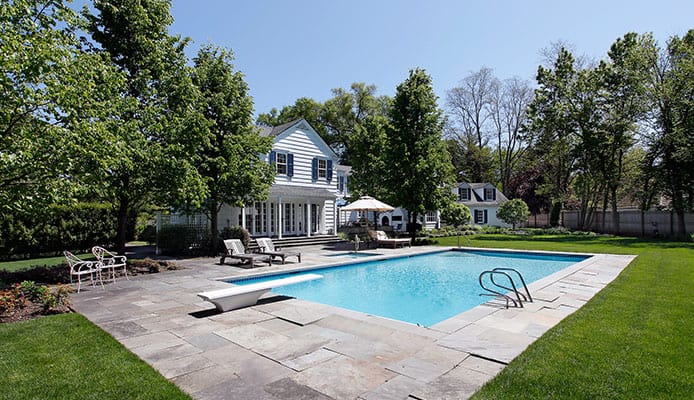
Diving boards are fun additions that can transform your pool into a playground for both adults and children. With all the joy they bring, the best diving boards should also be strong and stable enough to keep you fairly safe while enjoying them.
When searching for the best residential diving board, there are plenty of factors to think about – size, construction, flexibility, and many others. Carefully considering this will result in a diving board that will be exciting, reliable, and safe to use for many summers to come.
In our buying guide, we’ll walk you through all the key things you need to know when shopping. But before we jump in, check out our diving board reviews and discover some of the best boards on the market.
OUR TOP PICK
S.R. Smith Frontier II
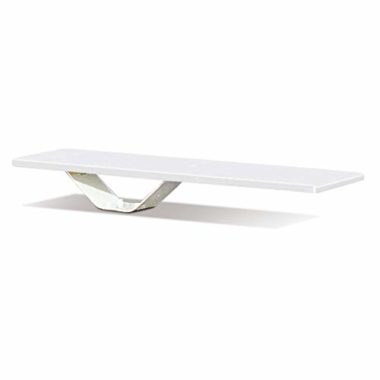
- Stand Out Features - Why We Love It
- High-strength steel improves board durability
- Non-slip SureFoot tread prevents accidents
- Outer layer resists scratching and fading
- Perfect fit for most residential pools
Length: 6 and 8 feet
Construction: Powder-coated steel, acrylic coating
Stand: Powder-coated steel
Weight capacity: 250 pounds
Colors: White, taupe with white sand
Warranty: 3 years
EDITORS CHOICE
S.R. Smith Flyte-Deck II Frontier III
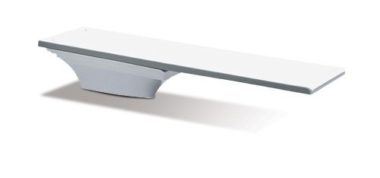
- Stand Out Features - Why We Love It
- Fiberglass and wood construction for improved flexibility
- SureFoot tread prevents accidental slipping
- All installation hardware included
- Plenty of color options to match with your surroundings
Length: 6 and 8 feet
Construction: Acrylic reinforced fiberglass
Stand: Powder-coated 316 stainless steel
Weight capacity: 250 pounds
Colors: Gray granite, silver gray, pewter gray, taupe, white, pebble
Warranty: 3 years
BEST VALUE
S.R. Smith Cantilever Frontier III
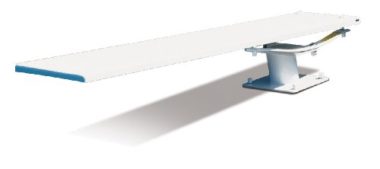
- Stand Out Features - Why We Love It
- Best diving boards if you want a high bounce
- High flexibility improves board performance
- Powder-coated steel ensures durability
- Easy installation with the included hardware
Length: 6 feet and 8 feet
Construction: Laminated wood core with acrylic coating
Stand: Powder-coated steel base and springs
Weight capacity: 250 pounds
Color: White
Warranty: 3 years
S.R. Smith TrueTread Salt Pool
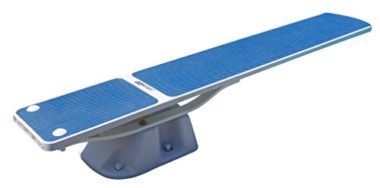
- Stand Out Features - Why We Love It
- Padded top surface provides a better grip
- Composite diamond-shaped material feels great
- Durable steel base with great rust-resistance
- Five color options to choose from
Length: 6 feet and 8 feet
Construction: Acrylic reinforced fiberglass
Stand: Powder-coated steel
Weight capacity: 250 pounds
Colors: Grey, taupe, white with a colored top (blue, grey, red)
Warranty: 3 years
How To Choose A Diving Board – Buying Guide
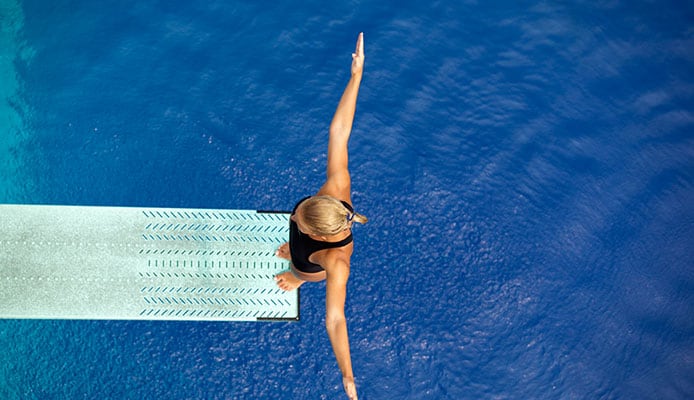
Pool Size (Depth)
The size of your pool is often going to be the most important factor in your buying decision. The main reason for this is safety when using the board. The higher you jump from the board, the deeper your pool needs to be.
Getting this right is very important because it could be very dangerous otherwise. Luckily, there are safety guidelines that you can follow to work out if a particular board model is suitable for your pool. All of the boards we featured come with tables that break these numbers down for you.
If your pool is on the lower limit when it comes to allowed depth, we advise that you get a more rigid board. While this will prevent you from jumping high, it will keep you safe from injuries even in a shallower pool.
Diving Board Material
The materials used to make a diving board will determine both its flexibility and overall durability. This is why most models are made from a blend of different materials to withstand the constant flexing.
For example, a wood core gives the board bounce, while a fiberglass reinforcement makes sure it retains the shape and doesn’t break. Additionally, an acrylic coating on the surface prevents scratching and damage.
As for the base, it’s usually made of stainless steel to give the board a good foundation. The base is under the most pressure, so strength is paramount here. As a bonus, steel bases often have a powder coating on the surface, improving their durability in a wet environment.
Non-Slip Surface
Most diving boards are coated with a material like acrylic. With all its protective properties, acrylic is also very slippery, and leaving the board like that could be dangerous. That’s why diving boards need non-slip padding on top to provide your feet with traction.
All the models we reviewed come with some sort of non-slip padding, with the TrueTread being the best diving board in terms of comfort and safety. However, some people don’t like having a heavily textured board under their feet, so personal preference has a part in this too.
Spring-loaded Base
A spring in the base will give you an extra amount of bounce, significantly increasing the amount of fun. However, a spring-loaded jump stand requires you to have a deeper pool to accommodate for the extra height you’ll get on every jump. For this reason, not all diving boards come with a spring in them, making them safer for residential use.
Most models rely only on the flexibility of the board to give you the bounce while the base remains rigid the whole time. Whether you’ll get a base with a spring or not is up to you, but be sure to meet the safety requirements if you do.
Weight Limit
When you start jumping on the edge, the diving board gets under immense pressure. Even with this, you don’t want it snapping from under you, so a good weight capacity is necessary.
Most diving board models are tested to weights up to 250 pounds, which is enough for most people. However, if you weigh more than this, you’ll need to look for stronger, reinforced models.
Diving Board Types
There are three types of boards available: diving platforms, diving boards, and jump boards. Diving platforms are solid platforms that are usually very high so they are often not suitable for most home pools.
Jump boards can be a great amount of fun because they bounce you very high in the air, but they require a greater pool depth for the same reason. Diving boards are a little stiffer but still a huge amount of fun and suitable for most pools.
Size Of The Board
Most residential diving boards are 6 or 8 feet long, but 10-foot models also exist. A longer board creates a better bounce and gives you more air time. On the other hand, this requires an increase in depth, so always check if your pool is safe for a longer board.
A 6-foot board is the most sensible option if your swimming pool isn’t very deep. And if you’re worried that a 6ft board is too close to the edge, you have nothing to fear because it gives you plenty of room.
Flexibility and Construction
While your first instinct may be to get a board that is as flexible as possible, it might not be the best idea. Not only do they send you higher into the air, but they are also harder to use in terms of balance. This decreased stability can be especially difficult for beginners.
If you have a deep pool and you’re a confident diver, it’s safe to get a replacement diving board that is more on the more flexible end of the scale. It’s important to get this right and find the appropriate balance of fun and safety, based on your skills.
Strength and Durability
Since diving boards aren’t something we buy every day, we expect them to be durable and last for many years. A board shouldn’t break or rust when exposed to the pool water. Durability mostly depends on the materials used to make the board.
All of the products that we’ve reviewed are made to the highest quality standards and will last for a very long time. With the constant flexing that comes with diving boards, you always want to make sure that you are buying a well-made product.
Compatibility With Your Pool
Getting a compatible board is necessary if you want it to pass the safety inspection. But even without the inspection, matching the board is important for your own safety.
As we’ve mentioned earlier, the length and construction of the replacement diving board need to be compatible with your swimming pool size. If you’re not sure about this, be sure to check the safety guidelines provided with each product.
Maintenance
Diving boards require very little maintenance, which is a great thing compared to many other accessories in and around your pool. Still, you need to have a regular inspection from time to time to make sure everything is in order.
You should regularly check for damage or cracks in the board itself, as well as signs of rust or other problems in the board base. Also, be sure to check that every piece is tightened and sitting in its place. If you notice anything wrong, reacting quickly might prevent potential injury and save you money.
You might also like: Best Pool Cover Reels
Warranty Period
The provided warranty period is a good indicator of product quality. It gives you peace of mind knowing that you are going to be protected and won’t lose your money if anything goes wrong.
All of the best diving boards we listed come with the same 3-year warranty offered by S.R. Smith. This shows you that they believe in their boards and want to help if you have any problems. Other manufacturers might offer a different type of warranty (shorter or longer), so be sure to always check before buying.
Safety in Use
When using a diving board, it’s very clear where the potential dangers can come from. There is a chance of slipping or hitting yourself against the pool wall or bottom.
Like we mentioned earlier, it’s very important that the pool is deep enough, the board is properly positioned, and that it’s covered with a non-slip material. Of course, teaching every potential user to be sensible is also necessary.
FAQs
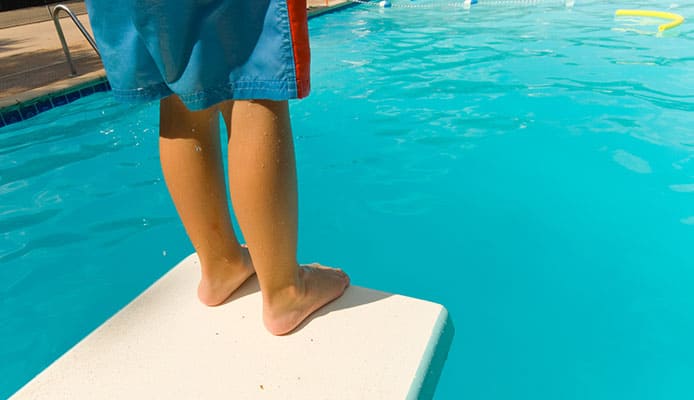
Q: Why Install A Diving Board?
A diving board can add a huge amount of fun and excitement. As long as your pool is deep enough, it will make it even more enjoyable. The best diving boards are relatively easy to install and enable a great new activity you can do in the pool.
Q: How Much Space Do I Need To Install My Diving Board?
Installing a board doesn’t require much space on the pool side. The largest part of the board will be hanging over the water, and only the base needs to be bolted in concrete. Bases usually have very small footprints, so you’ll be able to install a board even if you have limited space around the pool.
Q: What Is The Difference Between A Diving Board And A Jump Board?
The difference is in the amount of flexibility they have and, therefore, how much air time they will give you. Jump boards can get you a lot higher (requires a deeper pool), while the best diving boards are more balanced (better for most residential pools).
Q: How Deep Should A Pool Be For A Diving Board?
As a general rule, a residential swimming pool has to be at least nine feet deep to be considered safe for a diving board. Most pools with diving boards are between 9 and 12 feet deep at the deeper end, which enough for most types of boards.
Globo Surf Overview
Adding a diving board to your pool setup is a great idea if you like jumping around and doing diving tricks. If you pick the right board, both adults and kids will be able to enjoy it. As you’ve had the chance to see, you need to think about board construction (materials and weight capacity), its size, as well as pool depth before buying.
Using the information from this guide, we’re sure you’ll be able to find the best diving board for your swimming pool. And once you have it installed, everyone who visits you will want to join in on the fun.

